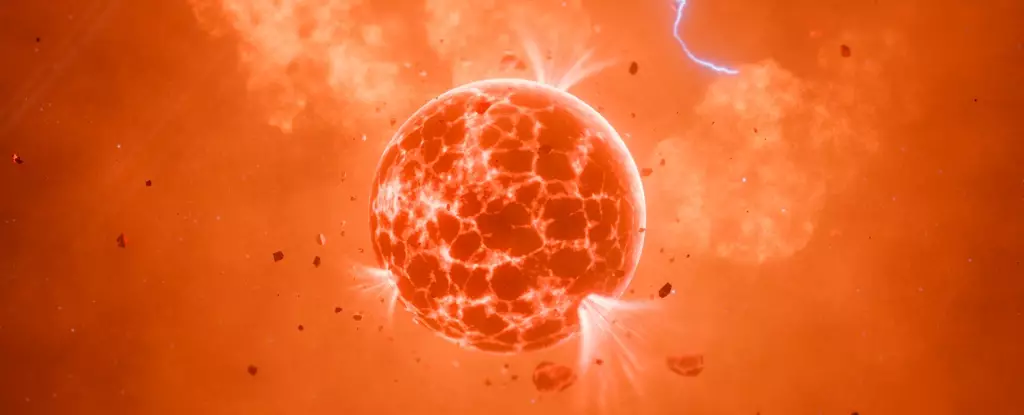The search for celestial bodies beyond our solar system has become one of the most exciting frontiers in modern astronomy. Recently, researchers have focused their attention on the discovery of exomoons—moons that orbit exoplanets. These fascinating objects could offer insight into the conditions that can lead to volcanism on distant worlds. In a remarkable new finding, astronomers have identified evidence of a volcanic exomoon around the gas giant WASP-49b, located approximately 635 light-years from Earth, igniting enthusiasm in the scientific community.
The evidence for volcanic activity comes from the detection of a significant sodium cloud encircling WASP-49b. This gas giant, much like Jupiter, appears to be inhospitable to volcanic activity due to its gaseous nature. It lacks the terrestrial geology typical of rocky planets. However, the sodium cloud’s behavior defies the expectations set by its planetary host, making a strong case for the existence of a volcanic moon orbiting this giant.
Astrophysicists have noted that the sodium is moving contrary to what should occur if it originated from the planet itself. As Apurva Oza of the California Institute of Technology points out, this peculiar movement provides “a really critical piece of evidence” for the moon’s volcanic characteristics. Simply put, if the sodium cloud’s movement aligns with the orbital dynamics typically observed in gas giants, it suggests an external source—an exomoon fueling this distinctive phenomenon.
The Rarity of Exomoon Discoveries
Despite the solar system’s bounty of moons, with nearly 300 identified compared to just eight planets, detecting exomoons remains an elusive endeavor. Since the discovery of exoplanets often involves intricate methods, including the transit method or radial velocity measurements, finding moons presents additional challenges. The weak signals produced by these satellites can be easily overshadowed by other cosmic phenomena, making exomoons a rare find in the vast expanse of space.
The unique case of WASP-49b stands as an outlier in the hunt for exomoons. Initial findings from the exoplanet’s atmosphere in 2017 hinted at a layer of sodium at unexpected altitudes. By 2019, Oza and his team formulated a hypothesis linking this sodium to a volcanic exomoon akin to Jupiter’s actively volcanic moon, Io. This theory provided an alternative explanation to the previously attributed idea of planetary winds creating the sodium signatures.
To investigate this phenomenon further, Oza’s research team utilized the European Southern Observatory’s Very Large Telescope, conducting observations over four nights. During these observations, it was determined that the sodium cloud was not a permanent feature but instead appeared and disappeared intermittently. The researchers observed this variability in sodium density as it vanished behind the exoplanet and its host star.
This dynamic behavior aligns more closely with the activity characteristics of a volcanic moon rather than any processes occurring on WASP-49b itself. Neutral sodium, which can be ionized by stellar radiation, ultimately supports the theory that its production comes from an ongoing process likely tied to volcanic eruptions occurring on the exomoon.
Through computer simulations, Oza’s team suggested that the sodium cloud is consistent with the presence of a volcanic exomoon orbiting WASP-49b approximately every eight hours. The gravitational interactions between the gaseous planet and its moon may create a chaotic environment, triggering periodic volcanic activity akin to the relationship between Jupiter and Io. This gravitational tugging could lead to massive eruptions, releasing sodium into the exoplanet’s environment.
Moreover, the proximity of the exomoon to its parent planet may lead to a concerning eventual fate. As it continues to lose mass through consistent volcanic outpouring, the exomoon’s orbit could decay, ultimately leading it into a collision course with WASP-49b—a destructive end for the moon.
The discovery of a volcanic exomoon in the vicinity of WASP-49b highlights the fascinating complexities of celestial bodies beyond our solar system. As our observational techniques improve and our knowledge deepens, we are only beginning to scratch the surface of the diverse worlds that populate our galaxy. The implications of these findings could pave the way for further investigations into volcanic activity on exomoons provides an exciting avenue for understanding planetary systems’ dynamics throughout the universe. Each new discovery brings us closer to comprehending the enigmatic dance of celestial bodies, fueling curiosity about what lies beyond our own blue planet.

